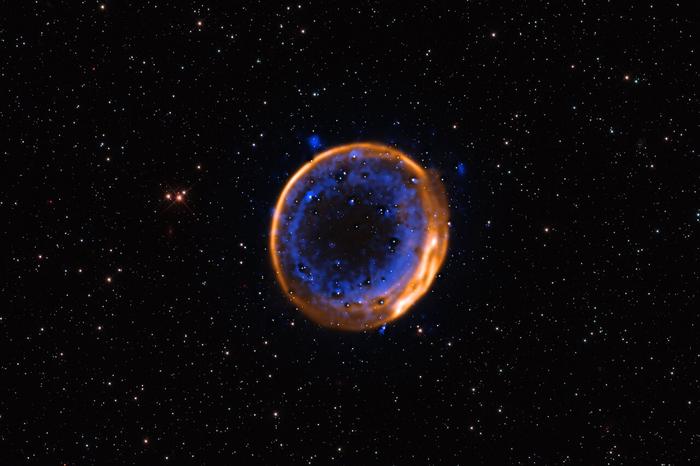Astronomers Capture First Visual Evidence of Double-Detonation in Type Ia Supernova
In an unprecedented breakthrough, astronomers have obtained the first direct visual evidence revealing that some stars perish through a double-detonation process. Using the European Southern Observatory’s (ESO) Very Large Telescope (VLT), researchers have examined the centuries-old supernova remnant SNR 0509-67.5, unveiling patterns that conclusively demonstrate the star underwent two explosive blasts before fading into cosmic history. This discovery sheds new light on the complex mechanisms underpinning some of the Universe’s most significant explosive events.
Type Ia supernovae, pivotal cosmic phenomena, are traditionally understood as the explosive ends of white dwarfs — dense, compact remnants of stars like our Sun that have exhausted their nuclear fuel. These explosions are not only fundamental to astrophysical research but also central to our comprehension of cosmic distances and the chemical enrichment of the Universe. Despite their critical role, the precise mechanism triggering Type Ia supernovae has been a matter of significant debate within the scientific community.
Prevailing models describe a white dwarf stealing material from a companion star in a binary system, steadily gaining mass until a critical threshold, known as the Chandrasekhar limit, is reached. This boundary generally triggers a catastrophic single explosion, obliterating the white dwarf and producing a bright supernova. However, recent theoretical work has proposed an alternative scenario — a double-detonation mechanism that precedes reaching this critical mass, involving two distinct explosive events.
The new study, spearheaded by Priyam Das of the University of New South Wales Canberra, utilized the Multi-Unit Spectroscopic Explorer (MUSE) instrument on ESO’s VLT to probe the chemical aftermath of SNR 0509-67.5 in extraordinary detail. MUSE’s advanced spectroscopic capabilities enable astronomers to map the distribution of various chemical elements within the expanding supernova remnant, offering critical insights into the explosion dynamics and the processes at play during the star’s demise.
Central to the discovery was the detection of calcium arranged in two concentric shells, a signature fingerprint that directly aligns with predictions for the double-detonation explosion model. This chemical layering results from an initial helium detonation on the white dwarf’s surface, followed by a subsequent core detonation induced by the inward-propagating shockwave. The concentric calcium shells represent the distinct explosive phases, providing a tangible record of the double-burst phenomenon.
Ivo Seitenzahl, who led the observational component from the Heidelberg Institute for Theoretical Studies, emphasized the importance of this finding, stating that it offers “a clear indication that white dwarfs can explode well before reaching the Chandrasekhar mass limit.” This revelation fundamentally challenges the long-standing paradigm that Type Ia supernovae only occur at this critical mass, suggesting a more nuanced and complex pathway to these cosmic explosions.
Understanding the explosion mechanics of Type Ia supernovae is not merely academic; it is tightly linked to the accurate calibration of cosmic distance measurements. Since these supernovae exhibit remarkably consistent intrinsic brightness, astronomers rely on them as “standard candles” to map the Universe’s expansion. The discovery of double-detonation mechanisms offers a new framework to comprehend variations in brightness, stability, and explosion outcomes, possibly refining models that underpin our cosmological models.
Moreover, Type Ia supernovae are the principal forges of iron in the cosmos, seeding galaxies and planetary systems—including our own Earth—with heavy elements essential for life. Unlocking the intricacies of their explosion processes aids in reconstructing the chemical evolution of galaxies and helps explain elemental abundances observed in the interstellar medium and beyond.
The detailed spectroscopic data from MUSE revealed an exquisitely layered structure within the supernova remnant. These layers provide a cosmic footprint of the explosion’s timing and mechanisms, verifying theoretical simulations of sub-Chandrasekhar mass explosions. Unlike traditional models that assume a single, violent burst, the double-detonation scenario accounts for complex grid patterns of elements and energy dispersal observed in the remnant’s morphology.
This research not only enriches our fundamental understanding of stellar death but also exemplifies the power and synergy of modern astronomical instrumentation and international collaboration. ESO’s VLT, equipped with MUSE, delivers unprecedented observational precision, enabling scientists like Das, Seitenzahl, and their colleagues from a global consortium to investigate phenomena previously beyond reach.
Further implications of this study extend to the refinement of supernova explosion models used in simulations of galaxy formation and evolution. By incorporating double-detonation pathways, astrophysicists can more accurately predict supernova rates, luminosities, and nucleosynthetic yields, enhancing the fidelity of cosmological models employed in both theoretical and observational studies.
Priyam Das described the visual evidence unveiled as not only a significant scientific breakthrough but also a “beautifully layered structure” — a cosmic spectacle that unravels the mesmerizing complexity of stellar cataclysms. The layered calcium shells provide a celestial narrative written in the elements, chronicling a death that was anything but simple.
This discovery opens avenues for future research, inviting astronomers to survey other Type Ia supernova remnants with similar techniques to identify double-detonation signatures elsewhere in the Universe. Confirming this mechanism’s prevalence could revolutionize the classification and interpretation of supernovae, influencing theoretical astrophysics, nucleosynthesis, and cosmology alike.
In conclusion, the observation of double-detonation fingerprints in SNR 0509-67.5 represents a milestone in astrophysics, transforming our understanding of how certain white dwarfs end their lives and challenge prior conceptions of supernova physics. As observational technologies continue to evolve, and as astronomers continue to delve deeper into the cosmos, such discoveries illuminate the profound and intricate processes shaping our Universe.
Subject of Research: Double-detonation mechanism in Type Ia supernovae evidenced through calcium layering in supernova remnant SNR 0509-67.5
Article Title: Calcium in a supernova remnant shows the fingerprint of a sub-Chandrasekhar mass explosion
News Publication Date: Not specified in the content
Web References:
References: Presented in Nature Astronomy by Das et al.
Image Credits: ESO/P. Das et al.; Background stars (Hubble): K. Noll et al.
Keywords
Supernova remnants, Type I supernovae, Observational astrophysics, Stellar explosions




